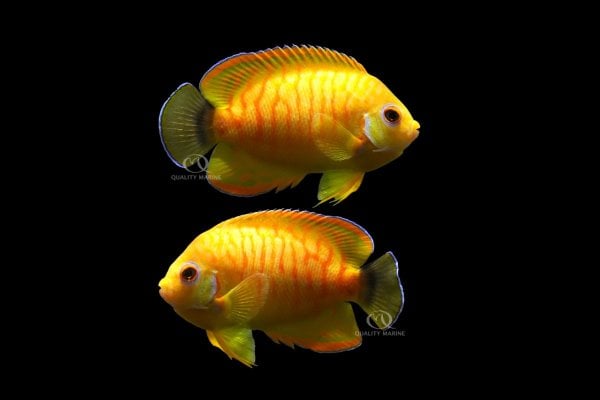There is a good variety of Pygmy and Dwarf Angelfish that are regularly available to North American aquarium enthusiasts, and they are universally excellent fish for the home aquarium. They are sized well, hardy, and invariably sport some amazing coloration or patterns. Then there are a few that are not so regularly available, some either have tiny wild ranges and come from prohibitive depths or are the ultra-rare products of unintentional hybridization and some even rarer ones are one off mutants, perhaps never to be seen again! Happily, today is not that day, because we're lucky enough to have not just one, but a selection of Tigerpyge Angels available! Want to know what's even cooler? We have both wild caught ones and aquacultured ones from our friends at Bali Aquarich!
Feeding the Tigerpyge things you DO want it to eat is also very straightforward, for both aquacultured and wild specimens. Wild fish tend to take to prepared foods very easily, and the aquacultured ones have been raised on them! Here, both are getting a mix of thawed meaty foods from Gamma, and a high quality, nutrient dense shot from Nutramar, called Algae and Color Boost. This diet helps enhance their vivid stark coloration and their general health. In the wild, this fish would graze constantly, so offering it some algae-based foods is beneficial, as are multiple feedings a day. Here we feed twice a day, and this is good, more wouldn't hurt, just decrease the amount of food per feeding when you increase the number of mealtimes. Click here to read more

Feeding the Tigerpyge things you DO want it to eat is also very straightforward, for both aquacultured and wild specimens. Wild fish tend to take to prepared foods very easily, and the aquacultured ones have been raised on them! Here, both are getting a mix of thawed meaty foods from Gamma, and a high quality, nutrient dense shot from Nutramar, called Algae and Color Boost. This diet helps enhance their vivid stark coloration and their general health. In the wild, this fish would graze constantly, so offering it some algae-based foods is beneficial, as are multiple feedings a day. Here we feed twice a day, and this is good, more wouldn't hurt, just decrease the amount of food per feeding when you increase the number of mealtimes. Click here to read more












